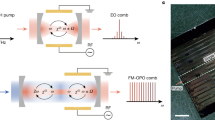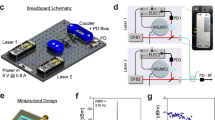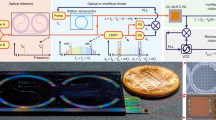Abstract
There has been increased interest in the use and manipulation of optical fields to address the challenging problems that have traditionally been approached with microwave electronics. Some examples that benefit from the low transmission loss, agile modulation and large bandwidths accessible with coherent optical systems include signal distribution, arbitrary waveform generation and novel imaging1. We extend these advantages to demonstrate a microwave generator based on a high-quality-factor (Q) optical resonator and a frequency comb functioning as an optical-to-microwave divider. This provides a 10 GHz electrical signal with fractional frequency instability of ≤8 × 10−16 at 1 s, a value comparable to that produced by the best microwave oscillators, but without the need for cryogenic temperatures. Such a low-noise source can benefit radar systems2 and improve the bandwidth and resolution of communications and digital sampling systems3, and can also be valuable for large baseline interferometry4, precision spectroscopy and the realization of atomic time5,6,7.
This is a preview of subscription content, access via your institution
Access options
Subscribe to this journal
Receive 12 print issues and online access
$209.00 per year
only $17.42 per issue
Buy this article
- Purchase on Springer Link
- Instant access to full article PDF
Prices may be subject to local taxes which are calculated during checkout





Similar content being viewed by others
References
Capmany, J. & Novak, D. Microwave photonics combines two worlds. Nature Photon. 1, 319–330 (2007).
Scheer, J. A. & Kurtz, J. Coherent Radar Performance Estimation (Artech House, 1993).
Valley, G. C. Photonic analog-to-digital converters. Opt. Express 15, 1955–1982 (2007).
Doeleman, S. in Frequency standards and metrology: Proceedings of the 7th symposium (ed Maleki, L.) 175–183 (World Scientific, 2009).
Santarelli, G. et al. Quantum projection noise in an atomic fountain: a high stability cesium frequency standard. Phys. Rev. Lett. 82, 4619–4622 (1999).
Weyers, S., Lipphardt, B. & Schnatz, H. Reaching the quantum limit in a fountain clock using a microwave oscillator phase locked to an ultrastable laser. Phys. Rev. A 79, 031803 (2009).
Millo, J. et al. Ultralow noise microwave generation with fiber-based optical frequency comb and application to atomic fountain clock. Appl. Phys. Lett. 94, 141105 (2009).
Eliyahu, D., Seidel, D. & Maleki, L. in Proceedings of the IEEE International Frequency Control Symposium, 811–814 (2008).
Savchenkov, A. A., Rubiola, E., Matsko, A. B., Ilchenko, V. S. & Maleki, L. Phase noise of whispering gallery photonic hyper-parametric microwave oscillators. Opt. Express 16, 4130–4144 (2008).
Callahan, P. T., Gross, M. C. & Dennis, M. L. in 2010 IEEE Topical Meeting on Microwave Photonics (MWP), 155–158 (2010).
Bartels, A. et al. Femtosecond laser based synthesis of ultrastable microwave signals from optical frequency references. Opt. Lett. 30, 667–669 (2005).
McFerran, J. J. et al. Low noise synthesis of microwave signals from an optical source. Electron. Lett. 41, 36–37 (2005).
Zhang, W. et al. Sub-100 attoseconds stability optics-to-microwave synchronization. Appl. Phys. Lett. 96, 211105 (2010).
Young, B. C., Cruz, F. C., Itano, W. M. & Bergquist, J. C. Visible lasers with subhertz linewidths. Phys. Rev. Lett. 82, 3799–3802 (1999).
Webster, S. A., Oxborrow, M. & Gill, P. Subhertz-linewidth Nd:YAG laser. Opt. Lett. 29, 1497–1499 (2004).
Millo, J. et al. Ultrastable lasers based on vibration insensitive cavities. Phys. Rev. A 79, 053829 (2009).
Ludlow, A. D. et al. Compact, thermal-noise-limited optical cavity for diode laser stabilization at 1×10−15. Opt. Lett. 32, 641–643 (2007).
Jiang, Y. Y. et al. Making optical atomic clocks more stable with 10−16 level laser stabilization. Nature Photon. 5, 158–161 (2011).
Thorpe, M. J., Fortier, T. M., Kirchner, M. S., Rosenband, T. & Rippe, L. Frequency-stabilization to 6×10−16 via spectral hole burning. (submitted to Nature Photonics).
Mann, A. G., Sheng, C. & Luiten, A. N. Cryogenic sapphire oscillator with exceptionally high frequency stability. IEEE Trans. Instrum. Meas. 50, 519–521 (2001).
Locke, C. R., Ivanov, E. N., Hartnett, J. G., Stanwix, P. L. & Tobar, M. E. Invited article: Design techniques and noise properties of ultrastable cryogenically cooled sapphire-dielectric resonator oscillators. Rev. Sci. Instrum. 79, 051301 (2008).
Grop, S. et al. ELISA: a cryocooled 10 GHz oscillator with 10−15 frequency stability. Rev. Sci. Instrum. 81, 025102 (2010).
Grop, S. et al. 10 GHz cryocooled sapphire oscillator with extremely low phase noise. Electron. Lett. 46, 420–422 (2010).
Diddams, S. A. et al. Improved signal-to-noise ratio of 10 GHz microwave signals generated with a mode-filtered femtosecond laser frequency comb. Opt. Express 17, 3331–3340 (2009).
Ivanov, E. N. & Tobar, M. E. Low phase-noise sapphire crystal microwave oscillators: current status. IEEE Trans. Ultrason. Ferroelectr. Freq. Control 56, 263–269 (2009).
Ma, L-S., Jungner, P., Ye, J. & Hall, J. L. Delivering the same optical frequency at two places: accurate cancellation of phase noise introduced by an optical fiber or other time-varying path. Opt. Lett. 19, 1777–1779 (1994).
Fortier, T. M., Bartels, A. & Diddams, S. A. Octave-spanning Ti:sapphire laser with a repetition rate of 1 GHz for optical frequency measurements and comparisons. Opt. Lett. 31, 1011–1013 (2006).
Taylor, J. et al. Characterization of power-to-phase conversion in high-speed P-I-N photodiodes. IEEE Photon. J. 3, 140–151 (2010).
Dawkins, S. T., McFerran, J. J. & Luiten, A. N. Considerations on the measurement of the stability of oscillators with frequency counters. IEEE Trans. Ultrason. Ferroelectr. Freq. Control 54, 918–925 (2007).
Acknowledgements
The authors thank A. Hati, L. Hollberg, D. Howe, C. Nelson, N. Newbury and S. Papp for their contributions and comments on this manuscript, and A. Joshi and S. Datta of Discovery Semiconductor for providing the 10 GHz InGaAs photodiodes. This work was supported by NIST. It is a contribution of an agency of the US Government and is not subject to copyright in the USA. Mention of specific products or trade names does not constitute an endorsement by NIST.
Author information
Authors and Affiliations
Contributions
T.M.F., M.S.K., F.Q., J.T. and S.A.D. built, characterized and operated the femtosecond lasers and measurement systems. J.C.B., T.R., N.L., A.L., Y.J. and C.W.O. constructed and operated the stable c.w. laser sources. S.A.D., T.M.F. and F.Q. acquired and analysed the data and prepared the manuscript.
Corresponding authors
Ethics declarations
Competing interests
The authors declare no competing financial interests.
Supplementary information
Supplementary information
Supplementary information (PDF 307 kb)
Rights and permissions
About this article
Cite this article
Fortier, T., Kirchner, M., Quinlan, F. et al. Generation of ultrastable microwaves via optical frequency division. Nature Photon 5, 425–429 (2011). https://doi.org/10.1038/nphoton.2011.121
Received:
Accepted:
Published:
Issue Date:
DOI: https://doi.org/10.1038/nphoton.2011.121
This article is cited by
-
Optical-referenceless optical frequency counter with twelve-digit absolute accuracy
Scientific Reports (2023)
-
Spatiotemporal mode-locking and dissipative solitons in multimode fiber lasers
Light: Science & Applications (2023)
-
Photonic comb-rooted synthesis of ultra-stable terahertz frequencies
Nature Communications (2023)
-
Cavity locking with spatial modulation of optical phase front for laser stabilization
Applied Physics B (2023)
-
Dissipative discrete time crystals in a pump-modulated Kerr microcavity
Communications Physics (2022)



